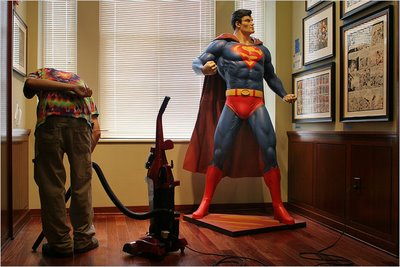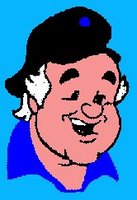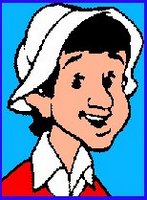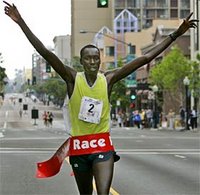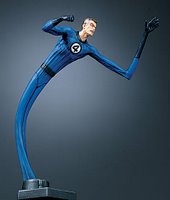Arnold's book changed my view of bodybuilding. I had considered bodybuilders' appearance as "grotesque" and abnormal. If you read through it once, the guys in the photographs start to look more normal, oddly enough. After reading Arnold's book I had enough knowledge to get started. I read it repeatedly, I was gradually memorizing it, and could read through the entire thing in a couple of hours, whenever I wanted to reignite the fire under my bottom.
Arnold's book is written in such a way that a person without prior knowledge of bodybuilding can read it and learn that bodybuilding does not involve steroids or synthetic hormones--that anyone who assumes otherwise is in for failure; it's only cheating one's self.
I found out later that Arnold currently admits years of steroid (ab)use and actually advocated their use among his peers and in pamphlets. But the argument he makes in his book is nevertheless sound, tempting as it is to make that ad hominem attack and call Arnold a hypocrite, etc. Nevertheless he is correct, in his book. Also, we didn't know things then that we know now. And he has enough integrity to come clean and just admit it, instead of lying.
I do respect Arnold for writing thebook; it was inspiring enough and also gave me a proper direction to take, so I highly recommend it. I would say that persuading someone to do what he suggests is a feat in itself. Few individuals are able to convince people to pursue the "pain." Arnold can say what he does confidently because if anyone does what he says, they actually get what he promises.
In short my caveat to you, reader, is: Arnold advises hanging up pictures of competitors on the wall to strive to look like them. YET he does not tell you anywhere in the book that he and likely most or all other competitors took steroids to get there. Don't set yourself up for frustration (not getting what you expect). Get the poster, the Muscular System.
What was actually disappointing to me though was not finding out about Arnold's past or how much of competitive bodybuilding is contaminated with banned substances.
Deep down, what disappointed me more was that some things he described as part of the joy of bodybuilding, I felt I didn't enjoy. He wrote about how bodybuilders love to look at their muscles in the mirror, flexing and posing--they revel in the satisfaction and payoff for their hard work.
I did not feel like that. I didn't even like looking at my own body unless it was while I worked out. I thought there was something wrong with me; I started wondering if I had body dysmorphia, an illness where one's perception of his own body is distorted, burdened with feelings of constant inadequacy about body appearance, even when it's great by most people's standards. It's like anorexia for males. Just that thought was depressing in itself. But I kept going back because lifting made me feel great afterwards and nothing in the world clears my head as well as a rigorous and prolonged period of exertion. I don't think it's just me, who is like this (hint, hint ;)
I had lost about 20 lbs of fat and added about 25 pounds of muscle over all that time, but I still felt that something was still not 'right.' I liked looking at my legs below the knee, but that was about it. I learned to leg press 720 lbs ten times and squat 400 lbs but I didn't care, and I still don't. Strength is one of my last concerns.
Thankfully, I don't have body dysmorphia. It wasn't until relatively recently that I understand better, the source of every problem I had with my physique and what was screwing up every upper body exercise I did: Upper Cross Syndrome. "Syndrome" makes it sound like a disease, but the word just means that it involves a number of typical characteristics, which are:
The upper crossed syndrome is defined as tightness of the upper trapezius, pectoralis major, and levator scapulae and weakness of the rhomboids, serratus anterior, middle and lower trapezius, and the deep neck flexors, especially the scalene muscles. linkI started fixing my shoulders about a year ago, using this program, the Perfect Posture Plan. At least 3 or 4 times in the past year, I had thought my shoulders were finally "fixed," I even posted on this blog about it. I underestimated how badly slumped forward my shoulders were; my entire shoulder girdle was pulled forward and locked in position that way, the older exercises I returned to after 'completing' PPP only contributed to the problem.
I did regain the ability to pull my shoulder blades together by doing the PPP, but I still had not relearned how to use my shoulder muscles in coordination with my chest and back, again.
What I describe may sound extreme, but I didn't look like Quasimodo. Destablized shoulders detrimentally affect how every lift is done, but the appearance is subtle. I see at least a handful of strangers daily who I would bet have upper-cross syndrome.
I understand now why I rarely liked how I looked in photographs; why I've always thrown a football "like a girl," and why my posterior deltoids were thin and underdeveloped. I don't even have a "before" picture of myself without clothes because I didn't want to take pictures of myself. And no matter how much or how hard I worked them, my pecs and deltoids didn't grow much; they looked partly good only while I was "training" them, yet I was merely filling them with a little more blood.
Now that my shoulders are pulled back farther and previously neglected muscles in my back are activated, it is a strange feeling to have shoulders, weird as that is to write. I feel like I have half a grapefruit at the top of each arm where clavicle meets humerus. It feels both good and funny.
I'm happy about it! I never considered posture to be that important before, Arnold doesn't mention it specifically, besides warning not to stand on stage with one's belly hanging out while others do their routines.
Posture is so important that it makes a good body look bad and a bad body look better.
No matter how well you think you "know" how to do an exercise there is always a little necessity for improvement or variation every so often.
The simplest way to describe 'upper cross syndrome' is that it is an imbalance between the chest and back, which oppose each other. It's like a tug-o-war and the front of the body is winning; the position of thee center flag (shoulders) is a good distance in favor of the "back team" buying dinner for the winning "chest team," except that the winning team doesn't get larger. All that happens: chest team gets shorter while back team gets longer. :|
Remember what Arnold writes about training every single muscle. Train your neck. Yes, your neck, especially where you're tilting your head back.
Keep going.
Don't Quit
When the road you're trudging seems all up hill.
When funds are low and the debts are high.
And you want to smile, but you have to sigh.
When care is pressing you down a bit.
Rest, if you must, but don't you quit.
Life is queer with its twists and turns.
As everyone of us sometimes learns.
And many a failure turns about
When he might have won had he stuck it out:
Don't give up though the pace seems slow -
You may succeed with another blow.
Success is failure turned inside out -
The silver tint of the clouds of doubt.
And you never can tell how close you are.
It may be near when it seems so far:
So stick to the fight when you're hardest hit
It's when things seem worst that you must not QUIT.
-author unknown

